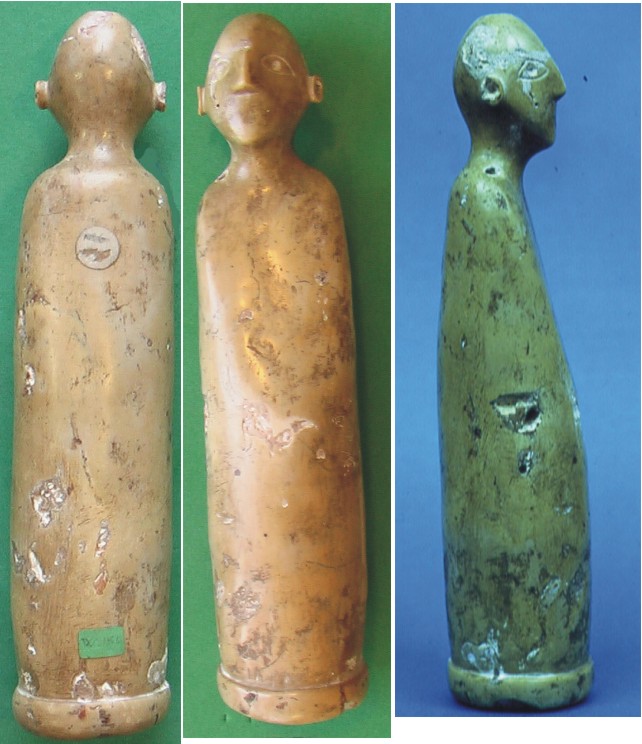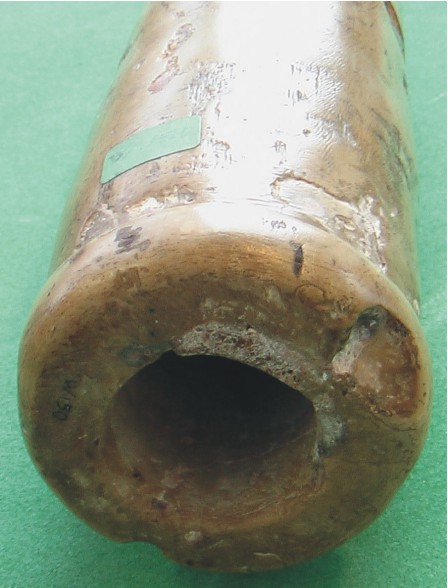W150
W150 Stone figure
 The first reference to this object occurs in the 1913 sale catalogue of items belonging to Robert De Rustafjael (Sotheby Catalogue 20.1.1913). Lot 219 has been described as:
The first reference to this object occurs in the 1913 sale catalogue of items belonging to Robert De Rustafjael (Sotheby Catalogue 20.1.1913). Lot 219 has been described as:
A very remarkable and exceedingly early penate figure in hard white stone, 12in high; the body cylindrical and with a wide raised band at the base; the head is of rudimentary type, the eyes shown by incised lines, the ears projecting and badly formed. A small hole is drilled at the top of the head; and the base is widely hollowed out to a depth of about 3 ½ inches. Similar objects in ivory and wood are known and have been describes as ”Staffs of Office” ”Magic Wands”, etc; very rare; possibly unique of this size; for a similar object see lot 761.
This item was later resold and purchased by Henry Wellcome at auction in May 1919 (Glendinings auction 5.5.1919, Lot 812).
The figure measures 29 cm high and is hollow up to a third of its height. The drilling is not perfect suggesting that the item was made in antiquity. However, the hole in the top of the head appears more modern.
This appears to be one of a type of object more commonly made from hippopotamus ivory. These items are usually hollow, have a loop at the end and may have a human head. Hendrickx and Eyckerman (2011) have produced a recent study on them. However, those with human heads (Hendrickx and Eykerman’s type A.5) usually have a pierced head. They are sometimes categorised in the same object group as ‘tags’ made from bone or ivory (see Hendrickx and Eyckerman 2011 for details of categorisations).
Here is a picture of the base of W150:

The tusk-like shape of our example (the Egypt Centre example is similar to the tusks in asymmetry of profile and hollowness) may be related to the pairs of decorated ivory tusks found in Naqada I and II graves (4000–3100 BC). Usually, one is solid and one is hollow and it has been suggested that these tusks represent male and female respectively. A pair of tusks was found in a woman’s grave at el-Mahasna near Abydos (Baumgartel 1960, 60). The pottery dates the grave to the Naqada I Period, that is 4000–3500 BC. Yet another made of hippopotamus tusk was found at Badari. Some of these tusks have been found to contain resin.
The fact that our item is made from stone need not mean it is a fake. There is also a similar breccia figure from Gebelein (Lyon 900000171, Hendrickx and Eyckerman 2011: 510). See also Phillips (1996, 56-57) for this and a schist example. Among closely related items (sometimes categorised in the same object group as ‘tusks’), stone sometimes appears to copy the ivory example. For example, the stone solid ‘tag’ from Petrie’s excavations of grave 1329 at Naqada, is almost identical to the ‘tusk’ from the same grave (Payne 1993, 237 nos. 1958 and 1959, fig. 81).
Some tusks have been found with found with lids. Petrie stated that tusks were often found with ‘tags’ (Petrie 1920, 33-34). Some of the round tags are perhaps stoppers. Suspension seems to be a feature of the tusks as they have holes for this purpose. Alternatively, the holes could be for tying on the lid.
It has been suggested that because this object is unusual it is a fake. We are not certain. On the one hand, there are no exact parallels in stone. On the other hand, there are similar items and the artefact does seem to be one of a pair. Another was sold at the same auction, whereabouts now unknown. This would suggest that if it is a fake it is a reasonably good one as the forger knew to make two, following the hippopotamus tusk examples which come in pairs. It is possible that the item is in part genuine but was embellished in more recent times.
Other Predynastic items in the Egypt Centre
Further Reading
Baumgartel, E.J., 1960. The Cultures Of Predynastic Egypt. Vol 2. Oxford. 60-65, Plate IV. London.
Griffiths, K-B, 1975. ‘A Prehistoric Stone Figure From Egypt’ in Anati, E. (ed.) Actes du Symposium International sur les Religions de la Préhistoire, Valcamonica, 18th-23rd Septembre, Capo di Ponte. Capo di Ponte, 313-316.
Hendrickx, S. and Eyckerman, M. 2011: ‘Tusks and Tags’, in: R.F. Friedman and P.N. Fiske (eds.), Egypt at its Origins 3, Orientalia Lovaniensia Analecta 205, Leuven, 497-570.
Payne, J.C. 1993. Catalogue of the Predynastic Egyptian Collection in the Ashmolean Museum. Oxford, 236-243.
Petrie, W.M.F., 1920. Prehistoric Egypt. London.
Phillips, T., 1996 (ed.) Africa–The Art of a Continent. Munich and New York.
Ucko, P.J., 1968. Anthropomorphic Figurines of Predynastic Egypt and Neolithic Crete with Comparative Material from the Prehistoric Near East and Mainland Greece. London.
Vandier, J., 1952. Manuel d’Archéologie Égyptienne, I: Les Épôques de Formation Les Trois Premières Dynasties. Paris. 415-435.